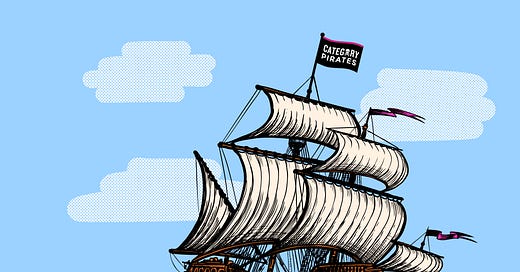Why Category Designers Must Avoid The “Better” Trap At All Costs
How to avoid competing for only 24% of the value opportunity of a category.
Dear Friend, Subscriber, and Category Pirate,
This Category Design Tip shares how to stop competing for a category’s table scraps.
On the Pirate Ship, we call this The “Better” Trap. Companies, entrepreneurs, writers, creators, and marketers fall into this trap any time they compete on features, price, and “brand.” This comparison marketing drives down margins collectively and competitors are stuck fighting for one tiny sliver of the pie.
To stay savvy and avoid the trap (our mini-books are the best maps), hop aboard The Pirate Ship and subscribe below:
“Better” is a trap.
Anytime a company makes a comparison statement, they are falling into the “better” trap.
Words that end in -er and “most/more-than” statements imply comparison. Because in order for something to be fast-er or smart-er or cheap-er, something else has to exist to give it meaning.
Here are some easy-to-spot examples:
Faster (faster than...what?)
Smarter (smarter than...what?)
Cheaper (cheaper than...what?)
More economical (more economical than...what?)
Most efficient (most efficient compared to...what?)
What’s really happening here is the company is making the unconscious, unquestioned, unconsidered, undiscussed decision to carry their brand into someone else’s category and try to convince the world that their product is “better.” It happens all the time. And it’s always a disaster.
Even the world’s most successful, most legendary marketers make this mistake.
Just look at Pepsi.
For more than 100 years, Pepsi’s entire marketing strategy has been in comparison to the category king of soda: Coca-Cola. Over the past 10 to 20 years, has Pepsi’s “better product” marketing strategy been working?
No.
If anything, it has further reinforced the fact that Coca-Cola is the king of the soda category.
Pepsi’s market share has been falling for more than a decade—which means, despite the company spending tens of millions of dollars on Super Bowl ads, these efforts haven’t had any meaningful impact on dethroning Coca-Cola’s leadership position.
Rather than falling into a never-ending comparison competition, category designers focus on creating a different future.
Don’t be “Better.” Be DIFFERENT!
The need to draw a product or feature comparison is irrelevant when you’re the Category King.
Instead of having a conversation about the past, you have a conversation with your customers and investors about the future—specifically, the future potential of the category.
For example: Elon Musk doesn’t talk about Tesla in the context of gasoline-powered engines, American car manufacturers, and legacy brands. He talks about Tesla in the future: a world where gasoline doesn’t exist and clean energy saves our planet.
So, what’s the value of Tesla?
If you valued the company through the lens of Ford’s historical performance, you were probably one of the many investors who lost their shorts shorting Tesla stock.
And if you valued the company through a category lens focused on future category potential, you were probably one of the many retail investors who became a Tesla millionaire.
Category designers, like Elon Musk, focus on creating net-new potential—and they get to enjoy the 76% slice of revenue pie as a result.
Whenever we point out the “better” trap, the most common thing we hear back is, “I get it, but this sounds risky.”
If that was your first thought, you’re likely in The “Better” Trap—and it’s time to escape.
Become A Category Designer
Want to unlock 50+ mini-books on Category Creation and Category Design, and receive new mini-books straight to your inbox?
Hop aboard!
Arrrrrrr,
Category Pirates







Love your work, very refreshing perspectives. I'm sold.
It is not true that “Elon Musk doesn’t talk about Tesla in the context of gasoline-powered engines”. He often shows comparison demos on stage with gasoline engines.